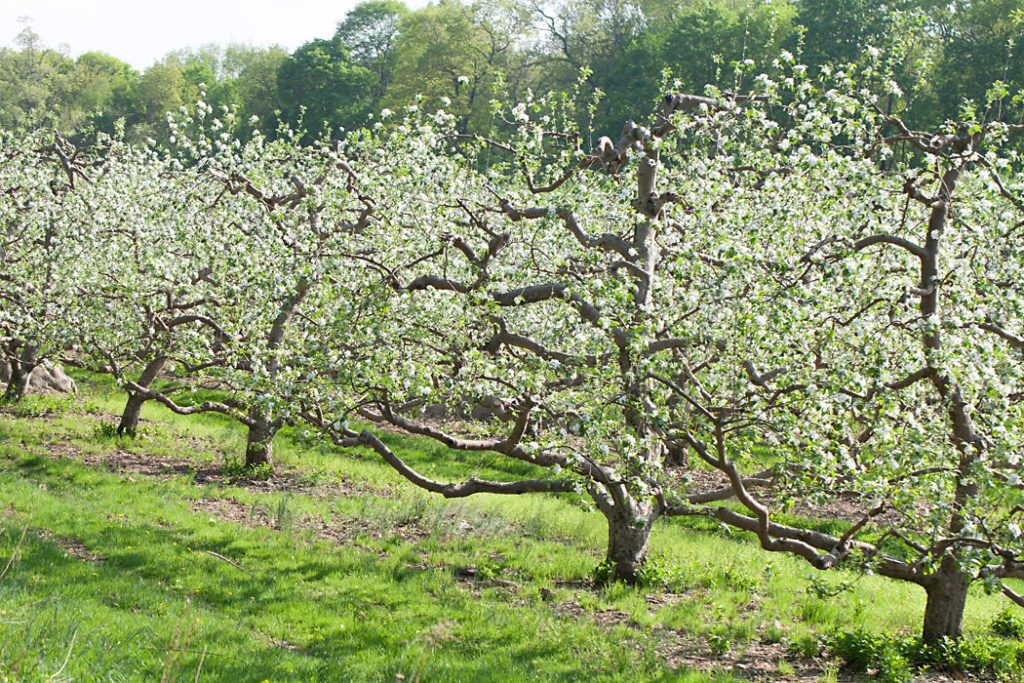
We can get any fruit or vegetable we want, at any time of the year, from anywhere in the world. This phenomenon of “global summer time” brings us fresh berries in February and crisp apples in June, but it’s a luxury that comes at a cost—both to our wallets and to the environment. Home orcharding, the practice of growing a diverse range of fruits and berries in our yards, offers a practical alternative that allows us to enjoy seasonal fruits picked at the peak of ripeness.
Many of us have golden memories of climbing apple or cherry trees in our childhood backyards. Crunching into a sun-ripened apple fresh from the tree simply cannot compare to eating an underripe facsimile that has been waxed, gassed, kept in cold storage for months, and shipped thousands of miles.
Fruit trees are great for everybody, especially kids. They provide shade, educational opportunities, and wholesome food. Fresh fruit is easily preserved for consumption in the winter months by canning, freezing, and drying.
In contrast to home-grown fruit, the majority of commercially available fruit, even organic, is primarily grown for its ability to withstand long-distance shipping, extended shelf life, and attractive appearance. Not only does this mean that fruit is often picked underripe—and hence lacking the flavor and nutrition found in fruit left to ripen naturally—but the demand for uniformity leads to a loss of genetic diversity. For example, of the almost 2,000 varieties of apples once grown, only 6 to 10 are widely available in grocery stores. Alternatively, growing your own fruit provides the opportunity to experience once popular, yet now endangered cultivars.
Increasing Genetic Diversity
Growing and consuming a diverse selection of fruits and other produce is critical to the stability and adaptability of our food system, as it is precisely this genetic diversity that enables systems to withstand and recover from natural or human-created disasters. For example, had 19th century Ireland cultivated more than just a few varieties of potatoes, it’s possible that certain varieties would have been more blight-resistance than others, and thousands of lives would have been spared. Similarly, in our current food system, the over reliance on a very small percentage of possible food crop varieties is a weakness, especially considering the recent erratic weather patterns. However, with greater genetic diversity, a resilient food system could be created that would withstand the vagaries of weather and pests.
One pragmatic approach to creating greater resiliency in our food system is planting a diverse range of crops, especially food-bearing trees and other perennials. Although southeast Iowa is already developing a fairly robust local food system, a greater emphasis on home orcharding would strengthen this trend. Besides, who wouldn’t want bushels of apples and pears from their own backyard?
A Return to Orchards
Looking at Iowa now, however, you would never guess that it was once the number one exporter of fruit in the country. Ever since an early hard frost in the late 1930s killed the majority of Iowa’s apple orchards, the state has yet to recover its rich fruit-growing heritage. Fortunately, over the last decade, Iowa has seen a revival of small-scale orchards and vineyards. The historical diversity of Iowa’s fruit can be renewed—and homeowners can play a critical role in that revival.
Growing Fruit Trees is Easy
Anybody with a bit of land can grow fruit trees. Anywhere with sufficient sunlight and decent drainage will suffice. Having poor soil should not dissuade one from planting trees or a garden, as any soil can be improved with compost and mulching. Although annual vegetable gardens produce a lot of food in a single season, they require constant upkeep and yearly preparation. Trees and berry bushes, however, practically grow themselves, as all they require is an occasional pruning and a seasonal application of mulch. In a good year, a healthy, mature pear or apple tree can produce over 150 pounds of fruit. Under ideal storage conditions, apples and pears can keep for up to nine months.
In choosing what to plant, there are certain factors to consider. Iowa has an extreme climate of hot, humid summers and cold, dry winters. Iowa is in USDA cold hardiness zone 5. Choose late flowering fruit and nut trees such as pawpaws, American persimmons, Asian pears, and chestnuts, as our late spring frosts can easily harm trees in bloom. Plants must be cold hardy and capable of resisting common problems such as brown rot and cedar apple rust. Other plants that work well in our climate are European pears, many types of berries, Japanese plums, and many varieties of apples such as Pristine, Liberty, and Blushing Golden. Sour cherries, selected varieties of mulberries such as the Illinois Everbearing, and many varieties of the walnut family also do well in zone 5. Grafted fruit trees can begin bearing fruit after 3 to 5 years, and can produce for 25 to 125 years.
Goji Berries, Kiwis & Quince
Although the majority of fruits historically grown in Iowa are apples, grapes, and berries, a wide variety of other fruits will grow well here. Doug Bullock, a renowned fruit explorer and nurseryman, has remarked that the climate of southeast Iowa is capable of supporting a greater variety of fruits, nuts, and berries than any place he has been outside of the tropics. Home growers can cultivate a wide variety of fruits, from productive natives to well adapted varieties such as goji berries, hardy kiwis, and quince.
Fruit trees are a critical part of our local food system. Planting a fruit tree today, a relatively small task, brings great satisfaction, bolstered ecological sustainability, and a holistically wonderful fruit experience. As a common saying goes, “The best time to plant a tree is 20 years ago.” But you can start today: leave a legacy and plan for the future!
